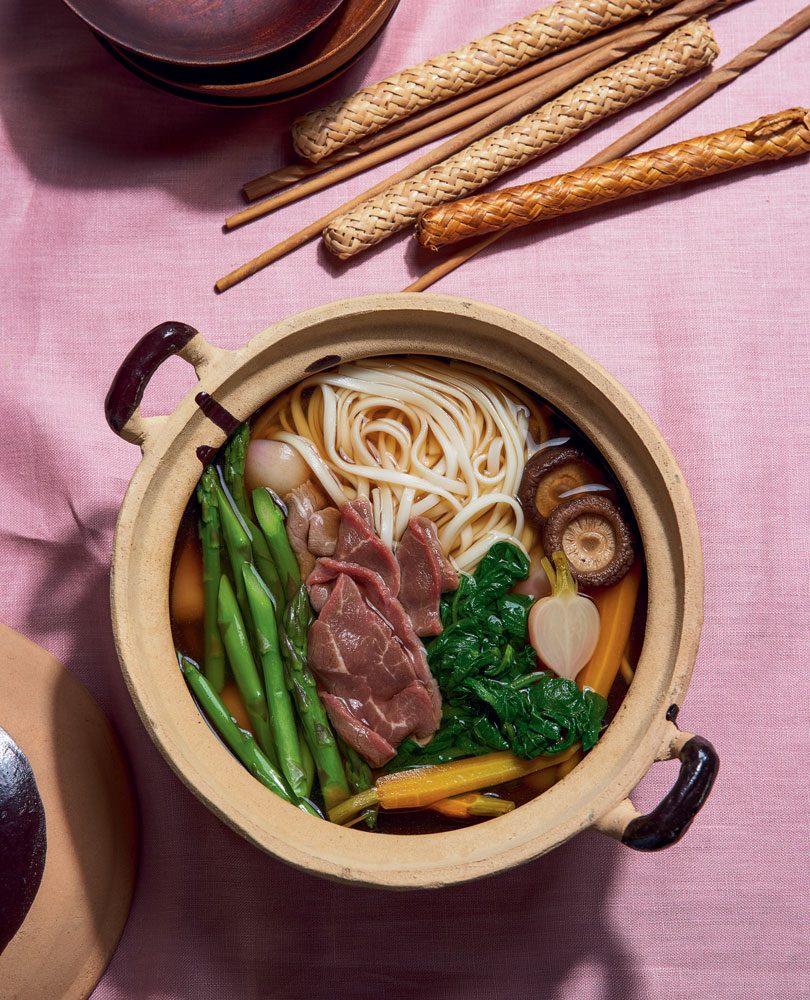NABEMONO UDON WITH BEEF
Ginny Grant

Serves
2Preparation
25 mins plus 12 hrs soakingCook
15 minsIngredients
| FOR THE DASHI | |
| 1 piece (approx 15g) kombu | |
| 15g bonito flakes (katsuobushi) | |
| FOR THE NABEMONO | |
| 8 dried shiitake | |
| 2 bundles of dried udon, or 2 packets of cooked udon | |
| 750ml dashi | |
| 2-4 teaspoons light soy sauce | |
| 2-4 teaspoons cooking sake | |
| 1 teaspoon sugar | |
| 6 radishes (and their tops), halved if large | |
| 6 baby carrots, peeled and halved lengthwise | |
| ½ bunch asparagus | |
| 150g beef, very thinly sliced (ideally freeze for 30 minutes beforehand to make slicing easy) |
On my first trip to Japan I arrived in Osaka and immediately caught a train to a tiny town in Shikoku to see a friend. Jet- lagged and hungry, I was taken straight to a truck-stop ramen shop for a great bowlful of noodles and soup, before picking up some beer from a vending machine and proceeding onwards to karaoke. As you do. I don’t remember what I ate, just that this tiny, steamy bar had a huge number of options in terms of broths, noodles, meats and fish to choose from and that I was famished and slurped it up enthusiastically.
This, however, is not that kind of a broth. This is light and clean, but umami-rich. Traditionally nabemono is made and served in a donabe (a clay pot) but it’s also good cooked in a saucepan. I’ve made an awasi dashi broth for the stock, but instant dashi makes for an easy, quick fix (use 2-3 sachets depending on how strong you would like it). If making a vegetarian/vegan broth, just use the kombu and omit the bonito. Adjust the vegetables to what you have and add to the pot in order of cooking times. The same, too, goes for the protein. Pieces of chicken are great (add early on in cooking), silken tofu (at the end), thinly sliced venison or pieces of fish.
Instructions
| 1. | FOR THE DASHI |
| 2. | Steep the kombu in 1 litre water for a minimum of 2-3 hours or leave overnight. |
| 3. | Put into a saucepan and slowly bring up to a simmer, removing the kombu when you see tiny bubbles forming (around 60°C). |
| 4. | When the bubbles start to rise (around 80°C) add the bonito flakes and turn off the heat. Leave for 15 minutes. |
| 5. | Strain the dashi through a sieve. |
| 6. | The dashi can be refrigerated for a few days or frozen and used as required. |
| 7. | Don’t discard the kombu and bonito flakes. You can make a second stock (niban dashi) by simmering for 10 minutes in 1 litre water. |
| 8. | Don’t waste those leftovers from the second batch of dashi, either. You can make tsukudani with the kombu. Thinly slice it, and cook with some water, soy sauce, mirin and a dash of sugar until very tender. It’s great as a side dish. The bonito flakes can be turned into furikake to top rice or even sprinkle over the nabemono. Simply dry-fry the bonito flakes then add soy sauce and mirin to glaze. Cool before using. Additions such as toasted shredded nori, chilli flakes or sesame seeds can also be added. |
| 9. | FOR THE NABEMONO |
| 10. | Soak the shiitake in 1 cup boiling water for 30 minutes then squeeze out the mushrooms, reserving the soaking liquid. |
| 11. | Remove and discard the mushroom stems and cut the caps in half, if large. |
| 12. | Cook the dried udon according to the packet directions, plunging into icy water to arrest cooking once done. |
| 13. | If using packets of pre-cooked udon, blanch quickly in boiling water then refresh in cold water. |
| 14. | Heat the dashi along with the shiitake liquid, soy sauce, sake and sugar. |
| 15. | Add the mushrooms. |
| 16. | Blanch the radish leaves (or use spinach) in boiling, salted water until tender. Drain, squeeze dry and roughly slice. |
| 17. | Add the radishes and carrots to the dashi and cook until tender. |
| 18. | Add the udon in the last few minutes (so it doesn’t overcook) along with the asparagus and radish leaves or spinach. |
| 19. | Add the beef at the very last minute and serve immediately. |
Recipes & food styling Ginny Grant / Photography Aaron McLean / Styling Fiona Lascelles

Leave a Reply